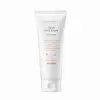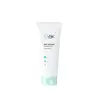What's inside
What's inside
 Key Ingredients
Key Ingredients

 Benefits
Benefits

 Concerns
Concerns

 Ingredients Side-by-side
Ingredients Side-by-side

Oryza Sativa Extract
AbsorbentGlycerin
HumectantSodium Cocoyl Glycinate
CleansingSorbitol
HumectantWater
Skin ConditioningSodium Lauroyl Glutamate
Disodium Cocoamphodiacetate
Cleansing1,2-Hexanediol
Skin ConditioningCucurbita Pepo Fruit Extract
Skin ConditioningVigna Angularis Seed Extract
Skin ProtectingLauryl Betaine
CleansingOryza Sativa Powder
Sodium Chloride
MaskingHydroxypropyl Starch Phosphate
Acrylates/C10-30 Alkyl Acrylate Crosspolymer
Emulsion StabilisingPolyquaternium-22
Hexylene Glycol
EmulsifyingEthylhexylglycerin
Skin ConditioningHydroxyacetophenone
AntioxidantCitric Acid
BufferingOryza Sativa Extract, Glycerin, Sodium Cocoyl Glycinate, Sorbitol, Water, Sodium Lauroyl Glutamate, Disodium Cocoamphodiacetate, 1,2-Hexanediol, Cucurbita Pepo Fruit Extract, Vigna Angularis Seed Extract, Lauryl Betaine, Oryza Sativa Powder, Sodium Chloride, Hydroxypropyl Starch Phosphate, Acrylates/C10-30 Alkyl Acrylate Crosspolymer, Polyquaternium-22, Hexylene Glycol, Ethylhexylglycerin, Hydroxyacetophenone, Citric Acid
Water
Skin ConditioningGlycerin
HumectantSodium Cocoyl Glycinate
CleansingSodium Lauroyl Glutamate
1,2-Hexanediol
Skin ConditioningHydroxypropyl Starch Phosphate
Centella Asiatica Extract
CleansingDaucus Carota Sativa Leaf Extract
Skin ConditioningLotus Corniculatus Leaf Cell Extract
Skin ProtectingCeramide NP
Skin ConditioningCeramide As
Skin ConditioningCeramide AP
Skin ConditioningCeramide Ns
Skin ConditioningCeramide EOP
Skin ConditioningCentella Asiatica Leaf Extract
Skin ConditioningCentella Asiatica Root Extract
Skin ConditioningMadecassoside
AntioxidantMadecassic Acid
Skin ConditioningAsiaticoside
AntioxidantAsiatic Acid
Skin ConditioningCoral Powder
AbrasiveAzadirachta Indica Leaf Extract
Skin ConditioningTheobroma Cacao Extract
Skin ConditioningMacrocystis Pyrifera Extract
Skin ConditioningEclipta Prostrata Leaf Extract
Skin ConditioningLavandula Angustifolia Extract
Skin ConditioningAlthaea Officinalis Leaf Extract
Skin ConditioningOcimum Basilicum Flower/Leaf Extract
TonicRosmarinus Officinalis Leaf Extract
AntimicrobialHouttuynia Cordata Extract
Skin ConditioningAnthemis Nobilis Flower Extract
MaskingEel Extract
HumectantHydrogenated Lecithin
EmulsifyingLauryl Betaine
CleansingButylene Glycol
HumectantSodium Chloride
MaskingDecylene Glycol
Skin ConditioningDipropylene Glycol
HumectantBeta-Glucan
Skin ConditioningGlyceryl Stearate
EmollientDextrin
AbsorbentSaccharomyces Ferment Filtrate
HumectantCholesterol
EmollientFructooligosaccharides
HumectantHydrolyzed Hyaluronic Acid
HumectantHydroxyacetophenone
AntioxidantEthylhexylglycerin
Skin ConditioningPentylene Glycol
Skin ConditioningTocopherol
AntioxidantWater, Glycerin, Sodium Cocoyl Glycinate, Sodium Lauroyl Glutamate, 1,2-Hexanediol, Hydroxypropyl Starch Phosphate, Centella Asiatica Extract, Daucus Carota Sativa Leaf Extract, Lotus Corniculatus Leaf Cell Extract, Ceramide NP, Ceramide As, Ceramide AP, Ceramide Ns, Ceramide EOP, Centella Asiatica Leaf Extract, Centella Asiatica Root Extract, Madecassoside, Madecassic Acid, Asiaticoside, Asiatic Acid, Coral Powder, Azadirachta Indica Leaf Extract, Theobroma Cacao Extract, Macrocystis Pyrifera Extract, Eclipta Prostrata Leaf Extract, Lavandula Angustifolia Extract, Althaea Officinalis Leaf Extract, Ocimum Basilicum Flower/Leaf Extract, Rosmarinus Officinalis Leaf Extract, Houttuynia Cordata Extract, Anthemis Nobilis Flower Extract, Eel Extract, Hydrogenated Lecithin, Lauryl Betaine, Butylene Glycol, Sodium Chloride, Decylene Glycol, Dipropylene Glycol, Beta-Glucan, Glyceryl Stearate, Dextrin, Saccharomyces Ferment Filtrate, Cholesterol, Fructooligosaccharides, Hydrolyzed Hyaluronic Acid, Hydroxyacetophenone, Ethylhexylglycerin, Pentylene Glycol, Tocopherol
 Reviews
Reviews

Ingredients Explained
These ingredients are found in both products.
Ingredients higher up in an ingredient list are typically present in a larger amount.
1,2-Hexanediol is a synthetic liquid and another multi-functional powerhouse.
It is a:
- Humectant, drawing moisture into the skin
- Emollient, helping to soften skin
- Solvent, dispersing and stabilizing formulas
- Preservative booster, enhancing the antimicrobial activity of other preservatives
Ethylhexylglycerin (we can't pronounce this either) is commonly used as a preservative and skin softener. It is derived from glyceryl.
You might see Ethylhexylglycerin often paired with other preservatives such as phenoxyethanol. Ethylhexylglycerin has been found to increase the effectiveness of these other preservatives.
Glycerin is already naturally found in your skin. It helps moisturize and protect your skin.
A study from 2016 found glycerin to be more effective as a humectant than AHAs and hyaluronic acid.
As a humectant, it helps the skin stay hydrated by pulling moisture to your skin. The low molecular weight of glycerin allows it to pull moisture into the deeper layers of your skin.
Hydrated skin improves your skin barrier; Your skin barrier helps protect against irritants and bacteria.
Glycerin has also been found to have antimicrobial and antiviral properties. Due to these properties, glycerin is often used in wound and burn treatments.
In cosmetics, glycerin is usually derived from plants such as soybean or palm. However, it can also be sourced from animals, such as tallow or animal fat.
This ingredient is organic, colorless, odorless, and non-toxic.
Glycerin is the name for this ingredient in American English. British English uses Glycerol/Glycerine.
Learn more about GlycerinHydroxyacetophenone is antioxidant with skin conditioning and soothing properties. It also boosts the efficiency of preservatives.
This ingredient is not irritating or sensitizing.
Hydroxypropyl Starch Phosphate is a modified starch used to help thicken a product.
It is also used in foods.
Lauryl Betaine is a surfactant. It helps cleanse your skin by gathering oil, dirt, and other pollutants to be rinsed away.
Chances are, you eat sodium chloride every day. Sodium Chloride is also known as table salt.
This ingredient has many purposes in skincare: thickener, emulsifier, and exfoliator.
You'll most likely find this ingredient in cleansers where it is used to create a gel-like texture. As an emulsifier, it also prevents ingredients from separating.
There is much debate on whether this ingredient is comedogenic. The short answer - comedogenic ratings don't tell the whole story. Learn more about comegodenic ratings here.
The concensus about this ingredient causing acne seems to be divided. Research is needed to understand if this ingredient does cause acne.
Scrubs may use salt as the primary exfoliating ingredient.
Learn more about Sodium ChlorideSodium Cocoyl Glycinate is a cleansing agent. It can be naturally derived or synthetically-created.
As a surfactant, it helps clean your skin by gathering dirt, oil, and other pollutants to be rinsed away more easily.
Sodium Lauroyl Glutamate is the sodium salt from the lauric acid of glutamic acid.
It is a surfactant and helps cleanse the skin. Surfactants gather oil, dirt, and other pollutants from your skin so they may be washed away easily.
Water. It's the most common cosmetic ingredient of all. You'll usually see it at the top of ingredient lists, meaning that it makes up the largest part of the product.
So why is it so popular? Water most often acts as a solvent - this means that it helps dissolve other ingredients into the formulation.
You'll also recognize water as that liquid we all need to stay alive. If you see this, drink a glass of water. Stay hydrated!
Learn more about Water